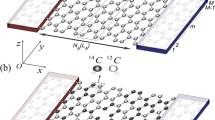Abstract
Self-powered nanoscale devices that scavenge heat from the surrounding environment show great promise in applications as biosensors or environmental sensors. Recently, defect-free monolayer gallium nitride (GaN) with a honeycomb structure was realized experimentally. In this paper, based on first-principles calculations and Boltzmann transport theory, the thermoelectric properties of monolayer GaN are investigated. Its electronic structure characteristics approach the condition of Mahan–Sofo’s best thermoelectrics, which leads to outstanding room-temperature Seebeck coefficients, up to 310 μV·K−1 with a hole concentration of 5 × 1018cm−3. Combined with the intrinsic high electron mobility, it then boosts the power factor of the GaN monolayer system. Moreover, due to the strong in-plane polarization nature of Ga–N bonds, the in-plane lattice vibrations exhibit extremely large anharmonicity, resulting in low thermal conductivity (6.4 W·m−1·K−1 at 300K). These results immediately cause a room-temperature figure of merit ZT of 0.17, indicating the P-type monolayer GaN is a superior candidate for low-dimensional thermoelectrics.




Similar content being viewed by others
References
X. Li, Z.S. Liu, D.G. Zhao, D.S. Jiang, P. Chen, J.J. Zhu, J. Yang, L.C. Le, W. Liu, X.G. He, X.J. Li, F. Liang, L.Q. Zhang, J.P. Liu, H. Yang, Y.T. Zhang, and G.T. Du, Sci. Technol. B, 2016, 34, p 041211.
N.I. Keda, Y. Niiyama, H. Kambayashi, Y. Sato, T. Nomura, S. Kato, S. Yoshida, Proc. IEEE, 2010, 98, p 1151–1161.
H. Ishida, R. Kajitani, Y. Kinoshita, H. Umeda, S. Ujita, M. Ogawa, K. Tanaka, T. Morita, S. Tamura, M. Ishida, T. Ueda, IEEE Int. Electron Devices Meeting (IEDM), 2016.
Z.Y. Al Balushi, K. Wang, R.K. Ghosh, et al., Nat. Mater. 2016, 15, p 1166.
W.L. Wang, Y. Li, Y.L. Zheng, X.C. Li, L.G. Huang, and G.Q. Li, Small, 2019, 15, p 1802995.
D.C. Camacho-Mojica, and F. López-Urías, Sci. Rep., 2015, 5, p 17902.
H. Gao, Y. Zhang, H. Ye, Z.Y. Yu, Y. Liu, and Y.F. Li, Physica E, 2018, 103, p 289–293.
Z.Z. Qin, G.Z. Qin, X. Zuo, Z.H. Xiong, and M. Hu, Nanoscale, 2017, 9, p 4295.
J. Zhang, J. Zhang, J. Appl. Phys., 2018, 123, p 035102.
M. A. Z. Mamun, M. Hasan, N. Mustakim and S. Subrina, TENCON 2019–2019 IEEE Region 10 Conference (TENCON), Kochi, India, 2019, pp. 52–56, doi: https://doi.org/10.1109/TENCON.2019.8929484.
K. Burke, J. Chem. Phys., 2012, 136, p 150901.
P. Giannozzi, S. Baroni, N. Bonini, M. Calandra, R. Car, C. Cavazzoni, and D. Ceresolli, J. Phys-Condens. Mat., 2009, 21, p 395502.
P.E. Blochl, Phys. Rev. B, 1994, 50, p 17953.
J.P. Perdew, K. Burke, and M. Ernzerhof, Phys. Rev. Lett., 1996, 77, p 3865.
A. Togo, F. Oba, and I. Tanaka, Phys. Rev. B, 2008, 78, p 134106.
G.K.H. Madsen, and D.J. Singh, Comput. Phys. Commun., 2006, 175, p 67–71.
M.V. Fischetti, and S.E. Laux, J. Appl. Phys., 1996, 80, p 2234.
L. Paulatto, F. Mauri, and M. Lazzeri, Phys. Rev. B, 2013, 87, p 214303.
G. Fugallo, M. Lazzeri, L. Paulatto, and F. Mauri, Phys. Rev. B, 2013, 88, p 045430.
A. Onen, D. Kecik, E. Durgun, and S. Ciraci, Phys. Rev. B, 2016, 93, p 085431.
Z.Z. Zhou, H.J. Liu, and D.D. Fan, Phys. Rev. B, 2019, 99, p 085410.
B. Peng, H. Zhang, H.Z. Shao, K. Xu, G. Ni, L.C. Wu, J. Li, H.L. Lu, Q.Y. Jin, and H.Y. Zhu, ACS Photonics, 2018, 5, p 4081–4088.
T.Q. Deng, X. Yong, W. Shi, Z.M. Wong, G. Wu, H. Pan, J.S. Wang, and S.W. Yang, J. Mater. Chem. A, 2020, 8, p 4257–4262.
J. Bardeen, and W. Shockley, Phys. Rev., 1950, 80, p 72–80.
M.Q. Long, L. Tang, D. Wang, Y.L. Li, and Z.J. Shuai, ACS Nano, 2011, 5, p 2593–2600.
M. Lee, and S.D. Mahanti, Phys. Rev. B, 2012, 85, p 165149.
M. Suzuki, T. Uenoyama, and A. Yanase, Phys. Rev. B, 1998, 58, p 10064.
J.J. Gu, L.R. Huang, and S.Z. Liu, RSC Adv., 2019, 9, p 36301.
W.L. Liu, and A.A. Balandin, J. Appl. Phys., 2005, 97, p 123705.
Acknowledgments
This work is supported by the National Natural Science Foundation of China under Grant No. 11304255 and the Open Project of State Key Laboratory of Environment friendly Energy Materials (No. 18kfhg10).
Author information
Authors and Affiliations
Corresponding authors
Ethics declarations
Conflict of interest
The authors declare that they have no conflict of interest.
Additional information
Publisher's Note
Springer Nature remains neutral with regard to jurisdictional claims in published maps and institutional affiliations.
Rights and permissions
About this article
Cite this article
Jiang, P., Ren, JC. & Zhang, X. High Room-Temperature Thermoelectric Performance of Honeycomb GaN Monolayer. J. Electron. Mater. 50, 2454–2459 (2021). https://doi.org/10.1007/s11664-021-08744-8
Received:
Accepted:
Published:
Issue Date:
DOI: https://doi.org/10.1007/s11664-021-08744-8




